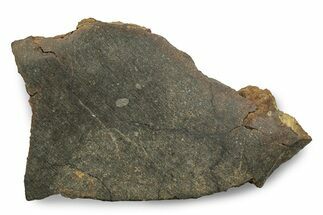This Specimen has been sold.
1.13" Oued Sfayat Meteorite Fragment (1.4 g) - Witnessed Fall
This is a 1.13" wide (1.4 gram) fragment of the Oued Sfayat meteorite that fell near Tindouf, Algeria in 2019. This gorgeous specimen has a fresh black fusion crust, visible shock veins, and fracture planes: a gorgeous specimen packed with unique features!
About the Oued Sfayat Meteorite
Oued Sfayat is the name given to an H5 chondrite that fell near Tindouf, Algeria in 2019. The fall was observed by local shepherds around 9:00 PM local time on May 16, who saw it fall at a relatively low angle and velocity moving west to east. The next day one of the shepherds followed the fall and shockwave path to the river valley named Oued Sfayat, where he recovered an 80-gram fragment covered in a fresh black fusion crust. Over the next few months, the shepherd group made regular trips to recover about 8 kilograms of material. Most were small 10 to 60-gram fragments, though several larger pieces have been found.
Oued Sfayat is characterized by its fresh black fusion crust and light gray, chondrule-free interior.
Oued Sfayat is the name given to an H5 chondrite that fell near Tindouf, Algeria in 2019. The fall was observed by local shepherds around 9:00 PM local time on May 16, who saw it fall at a relatively low angle and velocity moving west to east. The next day one of the shepherds followed the fall and shockwave path to the river valley named Oued Sfayat, where he recovered an 80-gram fragment covered in a fresh black fusion crust. Over the next few months, the shepherd group made regular trips to recover about 8 kilograms of material. Most were small 10 to 60-gram fragments, though several larger pieces have been found.
Oued Sfayat is characterized by its fresh black fusion crust and light gray, chondrule-free interior.
About Chondrites
Chondrites are stony (non-metallic) meteorites that have not been modified by either melting or differentiation of the parent body. They are formed when various types of dust and small grains in the early Solar System accreted to form primitive asteroids. Some such bodies are captured in the planet’s gravity well and pulled to the surface. They are by far the most common type of meteorite, representing about 86 percent of all meteorites that have fallen to Earth.
Prominent among the components present in chondrites are the enigmatic chondrules, millimeter-sized spherical objects that originated as freely floating, molten or partially molten droplets in space; most chondrules are rich in the silicate minerals olivine and pyroxene. Chondrites also contain particles of various metals such as nickel, iron, and aluminum. These formed at the very beginning of the solar system and aggregated over time: they are the oldest rocks known on Earth!
Chondrites are divided into about fifteen distinct groups on the basis of their mineralogy, bulk chemical composition, and oxygen isotope compositions. The various chondrite groups likely originated on separate asteroids or groups of related asteroids. Each chondrite group has a distinctive mixture of chondrules, refractory inclusions, matrix (dust), characteristic chondrule sizes, and other components. Other ways of classifying chondrites include weathering and shock. The L chondrite group is the most common of these.
Chondrites are stony (non-metallic) meteorites that have not been modified by either melting or differentiation of the parent body. They are formed when various types of dust and small grains in the early Solar System accreted to form primitive asteroids. Some such bodies are captured in the planet’s gravity well and pulled to the surface. They are by far the most common type of meteorite, representing about 86 percent of all meteorites that have fallen to Earth.
Prominent among the components present in chondrites are the enigmatic chondrules, millimeter-sized spherical objects that originated as freely floating, molten or partially molten droplets in space; most chondrules are rich in the silicate minerals olivine and pyroxene. Chondrites also contain particles of various metals such as nickel, iron, and aluminum. These formed at the very beginning of the solar system and aggregated over time: they are the oldest rocks known on Earth!
Chondrites are divided into about fifteen distinct groups on the basis of their mineralogy, bulk chemical composition, and oxygen isotope compositions. The various chondrite groups likely originated on separate asteroids or groups of related asteroids. Each chondrite group has a distinctive mixture of chondrules, refractory inclusions, matrix (dust), characteristic chondrule sizes, and other components. Other ways of classifying chondrites include weathering and shock. The L chondrite group is the most common of these.
TYPE
H5 Chondrite
LOCATION
Brukina Faso
SIZE
1.13 x .87 x .74", 1.4 grams
CATEGORY
ITEM
#265714
 Reviews
Reviews












